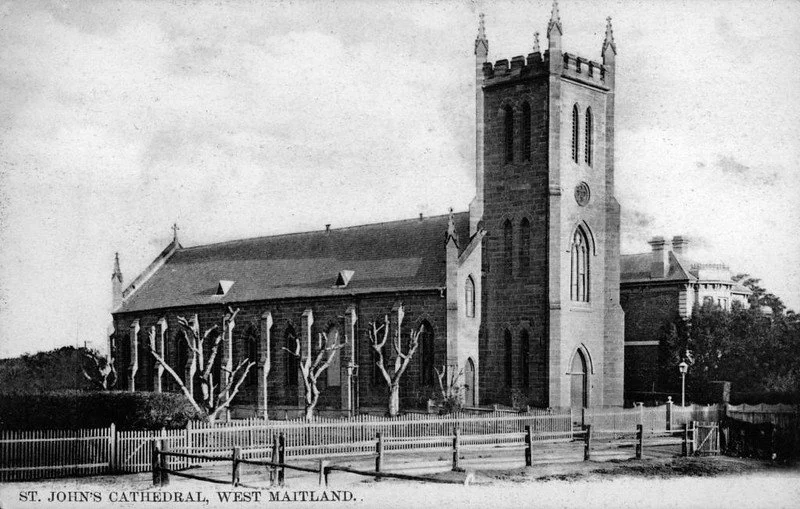Church and politics
St John’s Cathedral, West Maitland, c1910
St John the Baptist Chapel, formerly the Cathedral of the Maitland Diocese, was built by Dean Lynch and is one of the oldest churches in Australia still in use. The foundation stone, laid at Campbells Hill in 1840, was moved to its current position in Cathedral St, West Maitland in 1844. It was completed in 1846 with additions in 1862, became the Cathedral in 1866 and remained so until 1933.
The Maitland Mercury, between February 1843 and May 1844, published 24 lists of subscribers to the cost of building the church. The lists reveal much about the social and economic life of the times. Included are a number of high-profile members of the local and colonial community who were not Catholics, indeed some were not even Christians.
One notable donor was Major D’Arcy Wentworth who was listed as giving £5 (today the equivalent of about $600-$700).
Why did a staunch Anglican member of the military, economic and social elite, residing in Tasmania, give money to a humble Catholic church in Maitland, New South Wales?
The reasons were political.
Major D’Arcy Wentworth
D’Arcy Wentworth was the younger brother of William Charles Wentworth. Born in the colony and educated in England, he joined the army and returned to Tasmania as the commander of the 63rd Light Infantry stationed at Bothwell and then Launceston. He became a leading figure in Tasmania.
Right: Portrait of Major D’Arcy Wentworth.
(Libraries Tasmania)
1843 NSW Legislative Council elections
In 1843 the first election for the new Legislative Council of NSW was held. Under the then processes, each electorate had its unique polling date with the polls spread over many days. There were no residential requirements so to maximise your chances you nominated for multiple seats and then dropped out of upcoming polls once you were successful. Candidates with an eye on leadership, such as William Charles Wentworth, sought like-minded men (only men) to nominate to help form a government.
William Charles Wentworth (a local landholder but a shoo-in for Sydney) persuaded his brother D’Arcy to nominate for Northumberland (Newcastle, East Maitland and West Maitland). His opponent was Mr Alexander W Scott, a noted local farmer/industrialist member of the Scott family of Glendonbrook and Newcastle. While he was a local, Scott was conservative, pro the renewal of transportation and a relative newcomer to the Colony having arrived only in 1827. Wentworth used the symbol of the native born (the cornstalk) in his election campaign rallies and drew his support from anti-transportation men, especially ex-convict Catholic supporters of Irish exiles and Dean Lynch’s Total Abstinence Society.
Campaigning began in February 1843 and continued to the polling day of 20 June 1843. Quite clearly Wentworth courted Catholic electors. His Election Committee of 37 included sixteen (possibly eighteen) donors to Dean Lynch’s church, only some of whom were Catholic. Scott’s Committee of 26 had no Catholic members and only four (or possibly seven) donors to the Church.
Wentworth won Northumberland with a vote of 120 to 107 and thus became the Maitland area’s first elected parliamentarian. He retired in 1845, went back to Tasmania and died in 1861.
It’s possible the £5 donation made a difference to the election outcome. Voter numbers were small and Lynch, with the money in the bank, may have subtly influenced the few Catholics entitled to vote. He also had a calming influence on any disenfranchised Catholics thinking of disrupting the ballot.
References
Michael Belcher, ‘Our past: how donations to the church carried strong political motives’, Maitland Mercury, 4 October 2020.


